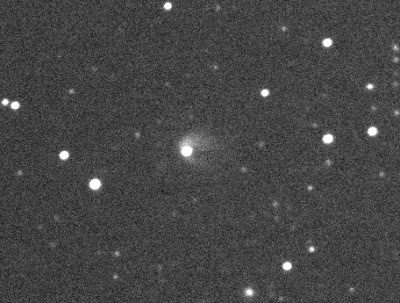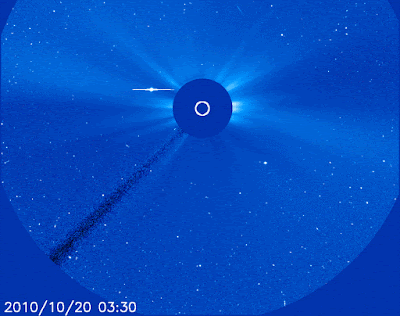Tomorrow November 04, at 13:50 UTC the Deep Impact spacecraft (renamed
EPOXI for this extended mission) will have a close encounter with the comet
103P/Hartley. At closest approach (roughly 700 kilometers), the spacecraft imager named MRI (Medium Resolution Imager) will achieve about 7 meters per pixel, and the nucleus should appear about 170 pixels across. When EPOXI will reaches the comet, it will be nearly 1.1 astronomical units away from the Sun and only 0.15 astronomical units from Earth.
Comet 103P/Hartley was discovered by
Malcolm Hartley in 1986 at the Schmidt Telescope Unit in Siding Spring, Australia. It belongs to the Jupiter family of comets (orbital period of 6.47 years) and it has a nucleus of about 2 km. So far only 4 comet nucleii have been explored by a spacecraft (Halley, Tempel 1, Borrelly and Wild 2), but comet 103P is unlike the others.
Discovery image (1986)
(U. K. Schmidt Telescope Unit, Siding Spring Observatory)
According to principal investigator Mike A'Hearn: "Comet Hartley 2 is smaller yet much more active than others comets. Although its core is only 2 km wide—about, a third the size of Tempel 1, it is spewing five times more gas and dust." The EPOXI team observed a strange activity on the comet in September: the abundance of CN in the comet's atmosphere jumped by a factor of five over an eight day period but there was no corresponding increase in dust. This was unexpected and never been seen in a comet before. In fact usually a gas surge is accompanied by a dust increment too.

(Credit: EPOXI)
To help the EPOXI team in their rendez-vous with the comet, the astronomical community (amateurs & professionals) are imaging the comet.
WISE spacecraft imaged the dust trail of 103P/Hartley on May 10, 2010. The dust trail (not to be confused with with the dust tail) is a "path of particles that the comet leaves during each of its trips through the inner solar-system". The extent of the trail seen in this view, behind the comet, is 1.8 million kilometers.
(Credit: WISE)
The comet was imaged on September 25, by the Hubble Space Telescope (HST). At the time of the Hubble observation, the comet was 1.153 astronomical units (172 million km) from the Sun and 0.218 astronomical units (32.6 million km) from Earth.
(Credit: NASA, ESA, and H. Weaver)
At the end of October 2010 (from 24 to 31 Oct.), the
Arecibo planetary radar system was used to make images of comet 103P/Hartley. The radar delay-Doppler images obtained show the nucleus to be a highly elongated, bilobate object with a long-axis dimension of at least 2.2 km. The images give a preliminary rotation period estimate of 18.1 +/- 0.3 hours, although a less likely period of 13.2 hours cannot be ruled out.

(Credit: Arecibo - NAIC)
Below you can see a graph showing the preliminary results of the
Italian Sezione-Comete /
CARA regarding the trend of the
Afrho parameter of 103P/Hartley in this apparation. For comparison in the graph there are also observations from the 1997/1998 apparition:
(Credit: CARA)
This is a list of all the observers who contributed to this graph with their observations: Paolo Bacci, Walter Borghini, Erik Bryssink, Dario Castellano, Gianni Galli, Ernesto Guido, Bernhard Hausler, Nick Howes, Rolando Ligustri, Herman Mikuz, Giannantonio Milani, Martino Nicolini, Carmen Perrella, Jure Skvarc, Giovanni Sostero, Roberto Trabatti.
Below you can see an image of 103P/Hartley imaged by N. Howes with the 2.0 meter Faulkes Telescope North (FTN) and processed by
M. Nicolini using the Median Coma Model (MCM) developed by himself. The MCM filter creates an artificial coma, based on the photometry of the original image, and subtract the original image itself in order to highlight the internal zones of different brightness that are very close to the inner core and that would normally be hidden from the diffuse glow of the comet:

In the anti-solar direction (from bottom center right), we see the brightest part of the coma that extends to form the tail. But the most interesting thing is in the direction of sunlight (from the center to the top left) where there is obviously some sort of "jet" With a PA (Position Angle) of about 50 degrees.
On Oct. 26, the spacecraft's two cameras, a High-Resolution Imager (HRI), and a Medium-Resolution-Imager (MRI), caught two jets firing off the comet's surface over a 16-hour period.
While waiting for the exciting flyby of tomorrow here a recent image of 103P/Hartley imaged on October 11, 2010 by E. Guido & G. Sostero:
by Ernesto Guido


















































